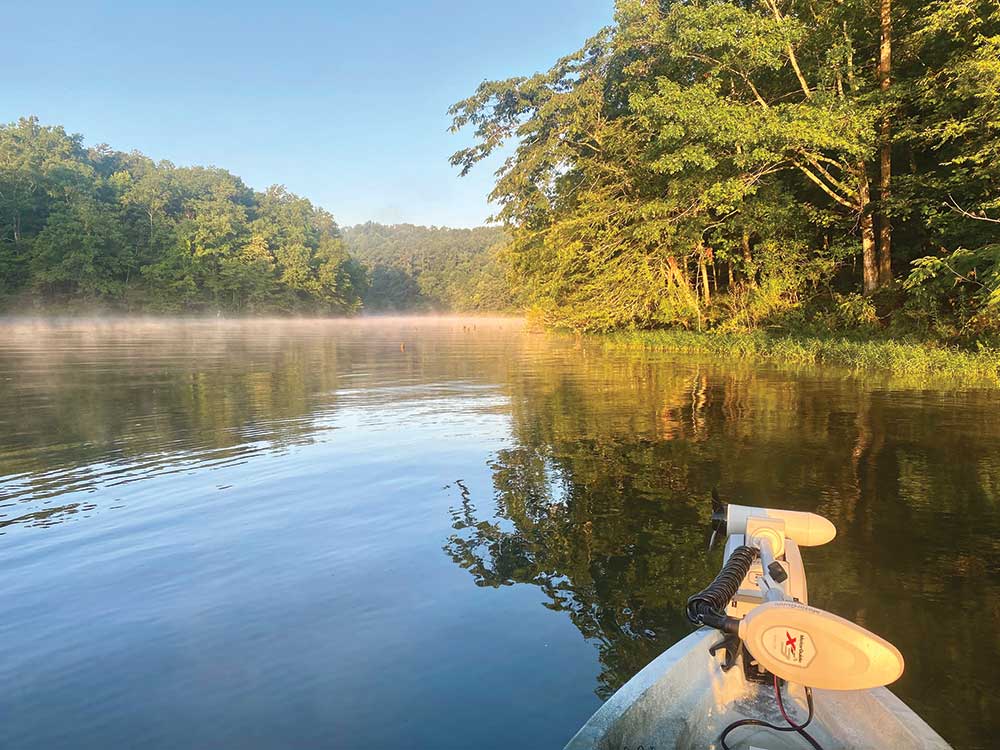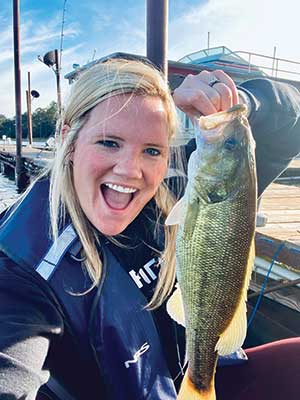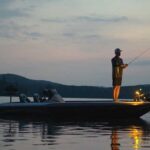
Paddle, pedal and have fun on the water
Story by Roxann Edsall
Submitted photos
Sitting out on the dock sipping your first cup of coffee, you watch the morning sun begin to cast a pinkish-orange glow on the water. Absorbed in the majesty of the morning, you startle as you catch the movement of the boat as it silently glides by just yards away.
Silent, that is, until the snap of the line as it is cast again, all the while drifting past the dock. Almost immediately, he jerks the line and reels in the prize. After a moment to inspect and admire his catch, the angler releases the fish off the side of his kayak.
Kayak fishing has exploded in popularity in recent years, thanks to huge improvements in materials, technology and available accessories. Fishing tournament organizers have even created competitive tournament series specifically designed for kayak anglers. Since having no live well makes transporting live fish to a weigh-in problematic, new rules were created for kayakers.
Kayak-specific tournaments and most tournaments with kayak divisions use cumulative length, rather than weight, as the unit of measure. Competitors in kayaks are often governed by the CPR (Catch, Photograph, Release) Rule, which includes catching, photographing the fish on a special measuring “ketch” board, then immediately releasing the catch.
The evolution of the kayak from simple shell to tricked out vessel, loaded with fish-finding tech and gear storage has helped to define the growth of the kayak fishing industry. Technology and electronics originally developed for bass boats have been redesigned, and in some cases, retrofitted for use in kayaks. Live scope electronics can be added to fishing kayaks, too.
Arguably, the biggest development propelling its popularity has been the application of pedal drives to the hull, allowing the kayak to be moved through the water without the need for a paddle. The hands-free option allows anglers to cast and reel without having to switch to a paddle to maneuver the kayak. As anglers are known to say, it’s a numbers game. And more casts equate to more fish.
“There are so many options when choosing a kayak,” says Allen Norris, co-owner of Cropwell’s Yak Shak and veteran kayak angler. “When you see something labeled fishing kayak, lights should go off to let you know it’s going to be more comfortable, more stable, and be able to carry more gear.”
He and Jessica, his co-owner and wife, ask a lot of questions of potential buyers to make sure they get them into the right kayak. Buyers will likely need to do a bit of research to be prepared to answer those questions, which would likely begin with what you want to do in your kayak and whether you’re looking for a sit-in or a sit-on type design.
The sit-on design, according to Norris, is more stable and many models are large enough to allow stand-up fishing. Also, with sit-on designs, there is no worry of taking on water, as they are designed to allow water to flow over the top and to drain through scupper holes.
After having the pedal/paddle, sit-in/sit-on, stand up/sit down discussion, then comes the question of motor versus muscle. Fishing kayaks can be fitted with small trolling motors, if desired, although Norris admits to being a bit of a purist. “When I’m kayak fishing, I want to be as tactical and stealthy as possible,” he says. “I don’t want to put more in the water than I have to. If you’re into lots of vegetation and stumps, you can’t use the motor anyway.”
In a sit-in kayak, be prepared to use a different set of muscles while casting, as opposed to those you’d use performing the same activity while standing. “Casting and aiming are very different when you are sitting,” says Norris.
“It’s very strenuous. A lot of people would describe kayak fishing as intense.” Being so close to the water and to the fish adds to the intensity of the fishing experience, Norris explains. “You can get close to the nooks and crannies that boats can’t, places where the fish really are.”
Adding to the excitement, he says, “You feel every movement on a catch in a kayak. You can also see the movement of wildlife and fish along the shore as you move through the shallow areas in coves and among boathouses and piers. Kayaks are perfect for wildlife photography, for exercise, and for just getting out and enjoying the water,” he adds. “The tranquility and therapy are very real.”
Josh Tidwell agrees wholeheartedly. He’s a huge fan of kayaking and fishing. He’s combined the two for more than 25 years and now runs a kayak rental and tour company at Big Wills Creek, a tributary to Neely Henry Lake. “It’s quite a bit of fun,” he says. “You get to be out in nature and even if you’re not catching, you’re still enjoying nature.”
Tidwell, an accomplished tournament fisherman, began fishing nearly three decades ago from creeks and riverbanks, either wading or by canoe. Kayak fishing made it easier for him to get to the tight places he wanted to fish. “Bass boats can’t get to where I go,” he says. “I like to fish smaller waters. I don’t want to look at the back of somebody’s house, when I could be looking at cliffs or waterfalls.”
Although he says he likes small water fishing, he says, kayaks are not just for lake fishing. He took his kayak to Gulf Shores a few years ago and hooked a 6-foot shark. His brother-in-law caught a 150–200-pound tarpon. For reasons which seem obvious, they did not try to bring it aboard their kayaks. “We got dragged all over the place. That’s part of the appeal,” he laughed. “You just have to prepare for it. And don’t go alone!”
The Coosa River system offers a variety of fish, from crappie to catfish, to several species of bass, including the Alabama bass. “On Logan Martin, I’ve pulled in a 15-pound channel catfish in my kayak,” says Norris. “I’ve seen a 50-75-pound catfish pulled in, unfortunately not by me.”
Strategies for success in kayak fishing are somewhat different, Norris explains. “We attack fishing in a very different way. We don’t fish the open waters as much as we do the tighter places. Where the bass boat world is launch as fast as possible, get to your spots as fast as possible, and cover lots of water. We might launch and stay near that launch fishing the harder to get places and cover only a mile or two.”
No matter what type of vessel you use or how you fish, all nautical rules apply. Kayaks are no exception. Before sunrise and after sunset, kayaks must have a stern light. The same holds true for red and green navigation lights. These are especially important for kayaks, which sit lower in the water and are harder to see.
Equipment add-ons for safety and for convenience and comfort make kayaking an activity perfect for anyone ages 5 to 95. Your grandpa’s kayak may have given you the inspiration to learn, but it is definitely not the only design option anymore. Today’s kayaks are lighter and stronger. They offer options in how they are propelled, how you fit into it and how you maneuver it. They can be outfitted for whatever activity you want to do on the water.
A final reminder that whatever fun you’re having in a kayak, be sure to remember safety is paramount. Alabama law requires all boaters, including kayakers to have a personal floatation device onboard for each occupant.
While it’s not required that boaters wear them, it’s a good idea. It’s also a good idea to always include water, a hat, and sunscreen in your float plan.
You may catch a beautiful sunrise, too, so don’t forget your camera. And give a wave to the lady sipping coffee on the dock as you drift by.

















